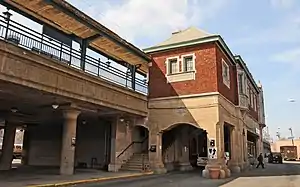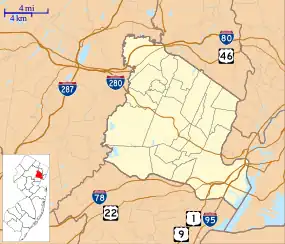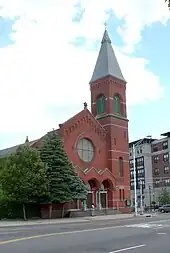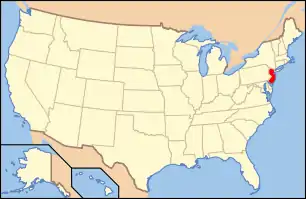Brick Church station
Brick Church is an active commuter railroad station in the city of East Orange, Essex County, New Jersey. The station, one of two in East Orange, is located next to the Temple of Unified Christians Brick Church, designed with brick architecture. The other station, located 0.6 miles (0.97 km) to the east, is the namesake East Orange stop. Trains from the station head east on New Jersey Transit's Morristown Line and Gladstone Branch to New York Penn Station and Hoboken Terminal while westbound trains service stops out to Gladstone and Hackettstown. Like its sister station, Brick Church contains three tracks and two platforms (a side platform and an island platform). However, it is not accessible for the handicapped.
Brick Church | |||||||||||||||
|---|---|---|---|---|---|---|---|---|---|---|---|---|---|---|---|
 Looking east toward downtown East Orange | |||||||||||||||
| General information | |||||||||||||||
| Platforms | 1 side platform and 1 island platform | ||||||||||||||
| Tracks | 3 | ||||||||||||||
| Connections |
| ||||||||||||||
| Other information | |||||||||||||||
| Fare zone | 4 | ||||||||||||||
| History | |||||||||||||||
| Opened | November 19, 1836[1] | ||||||||||||||
| Rebuilt | December 1880[2] April 21, 1921–December 18, 1922[3] | ||||||||||||||
| Electrified | September 22, 1930[4] | ||||||||||||||
| Passengers | |||||||||||||||
| 2017 | 2,041 (average weekday)[5][6] | ||||||||||||||
| Services | |||||||||||||||
| |||||||||||||||
| |||||||||||||||
Brick Church Station | |||||||||||||||
 | |||||||||||||||
 | |||||||||||||||
| Location | Brick Church Plaza, East Orange, New Jersey | ||||||||||||||
| Coordinates | 40°45′56″N 74°13′10″W | ||||||||||||||
| Area | 2 acres (0.8 ha) | ||||||||||||||
| Built | 1921 | ||||||||||||||
| Architect | Nies, F.J. | ||||||||||||||
| Architectural style | Tudor Revival, Jacobethan Revival | ||||||||||||||
| MPS | Operating Passenger Railroad Stations TR | ||||||||||||||
| NRHP reference No. | 84002636[7] | ||||||||||||||
| Added to NRHP | June 22, 1984 | ||||||||||||||
Railroad service through East Orange began with the opening of the Morris and Essex Railroad on November 19, 1836 to Orange. The railroad stopped at the residence of local attorney Matthias Ogden Halsted each day for him to commute. He soon provided a station for commuters to use as well as himself, and hired a family to operate it, without charging the railroad. Locals helped fund and build a new depot in 1880.[2] The current station opened on December 18, 1922 when the railroad tracks through the city were elevated by the Delaware, Lackawanna and Western Railroad. The brick headhouse at Brick Church station were added to the New Jersey and National Registers of Historic Places in 1984 as part of the Operating Passenger Railroad Stations Thematic Resource.[8][9]
History
The line that currently runs through East Orange began in 1835 with the charter of the Morris and Essex Railroad, being approved by the New Jersey State Legislature on January 29.[10] Service through the city of East Orange began on November 19, 1836 from Newark to The Oranges. With the construction of the railroad, Matthias Ogden Halsted (1792–1866), a local property developer took advantage of the one train a day that went to Newark. The railroad dropped Halsted off at his house and picked him up at his house rather making a trip to a station. Halsted offered at no cost to build a proper station at the site of the Brick Church station, and did so for the railroad.[11]
Station layout

The station has two low-level platforms serving all three tracks.
| P Platform level |
Side platform, doors will open on the right | |
| Track 3 | ← Morristown Line toward Dover or Hackettstown (Orange) ← Gladstone Branch weekdays toward Gladstone (Orange) | |
| Track 1 | ← Morristown Line toward Dover or Hackettstown (Orange) ← Gladstone Branch weekdays toward Gladstone (Orange) Morristown Line, Gladstone Branch toward Hoboken or New York (East Orange) → | |
| Island platform, doors will open on the left or right | ||
| Track 2 | Morristown Line, Gladstone Branch toward Hoboken or New York (East Orange) → | |
| G | Street level | Station building, ticket machines, parking |
See also
Bibliography
- Douglass, A.M. (1912). The Railroad Trainman, Volume 29. Cleveland, Ohio: Brotherhood of Railroad Trainmen. Retrieved April 3, 2020.
- New Jersey State Board of Assessors (1888). Annual Report of the State Board of Assessors of the State of New Jersey, Volumes 4-5. Camden, New Jersey: S. Chew, Printer. Retrieved April 3, 2020.
- Taber, Thomas Townsend; Taber, Thomas Townsend III (1980). The Delaware, Lackawanna & Western Railroad in the Twentieth Century. Vol. 1. Muncy, PA: Privately printed. ISBN 0-9603398-2-5.
- Whittemore, Henry (1896). The Founders and Builders of the Oranges. Newark, New Jersey: L.J. Hardham. Retrieved April 3, 2020.
References
- Douglass 1912, p. 339.
- "A new depot has been erected..." The Montclair Times. December 4, 1880. p. 3. Retrieved February 18, 2020 – via Newspapers.com.

- "D., L. & W. Opens New Elevated Line". The Paterson Evening News. December 18, 1922. p. 1. Retrieved March 5, 2019 – via Newspapers.com.

- "Edison Pilots First Electric Train Over Orange-Hoboken Route". The Passaic Daily News. September 22, 1930. p. 5. Retrieved January 31, 2021 – via Newspapers.com.

- "QUARTERLY RIDERSHIP TRENDS ANALYSIS" (PDF). New Jersey Transit. Archived from the original (PDF) on April 19, 2013. Retrieved January 4, 2013.
- "How Many Riders Use NJ Transit's Hoboken Train Station?". Hoboken Patch. Retrieved July 18, 2018.
- "National Register Information System". National Register of Historic Places. National Park Service. March 13, 2009.
- Monmouth County Listings, National Register of Historic Places. Accessed September 2, 2007.
- East Orange New Jersey Transit Railroad Station Survey
- New Jersey State Board of Assessors 1888, p. 58.
- Whittemore 1896, p. 407.
External links
![]() Media related to Brick Church (NJT station) at Wikimedia Commons
Media related to Brick Church (NJT station) at Wikimedia Commons
